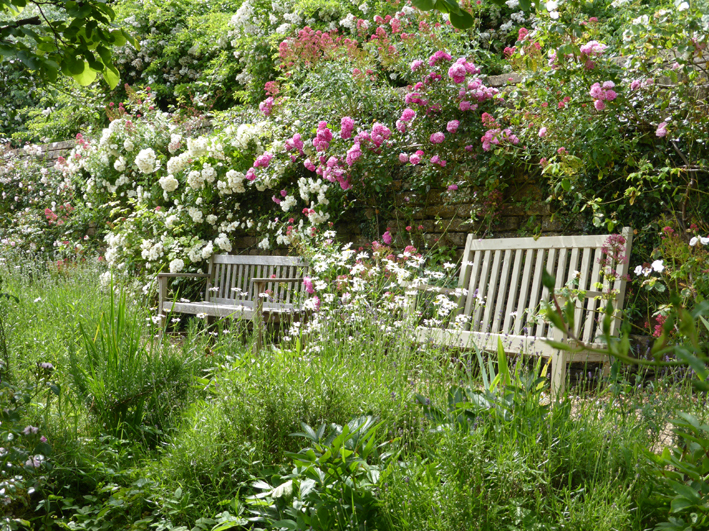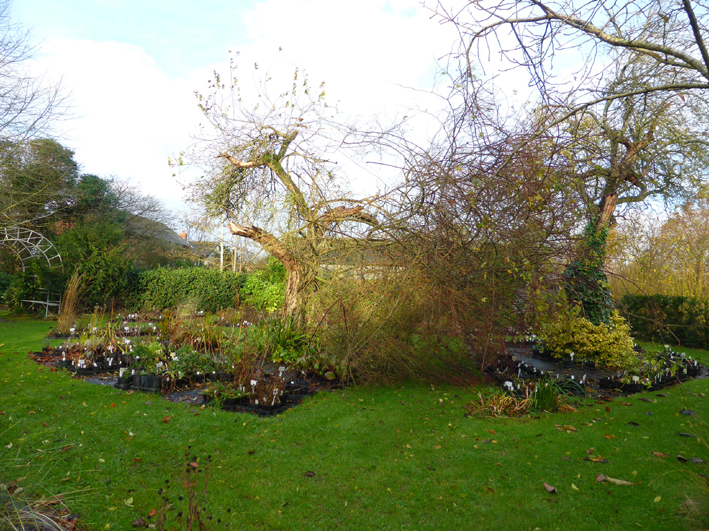Jill's Jots
Roses in Trees
I must confess to never liking roses, in fact I used to say they were my least favourite flower, I never even liked the smell of them! But I suppose it was because I had only really thought about formal, rather stiff rose gardens and probably how thorny they were when I tried to retrieve an errant football! But on moving here I decided that the old fruit trees which we inherited would look far more interesting with roses tumbling through them. I wonder where that thought came from, isn't it funny how thoughts about gardens come to you from the most unlikely places and at the most unlikely times - even in the bath! As to how to decide which to choose, very difficult when you know nothing about them but I decided that any rose I grew had to look natural, with simple flowers and preferably with hips to follow. I did not consider scent at that point - all fool me!

So 'Rambling Rector' was the first and planted to grow through an elderly damson which faced our neighbours windows, just across the lane. Well it certainly rambled and rambled and was magnificent. I chose this because as it was a very old rose, prior to 1912 and some sources think it is the original Musk rose, Rosa moschata. Also I could just imagine it rambling through an old rectory garden or perhaps named because the Rector rambled around the countryside rather than when he was giving a sermon! Then 'Bobbie James' was added to a very gnarled apple tree which formed a focal point in our sales area. I also added a Clematis 'Purpurea Plena Elegans' to this planting. Even if it sounds like I am boasting, I must say the combination was a true success. 'Bobbie James' (1960) was found and named by Graham Stuart Thomas in memory of his friend and fellow rose lover the Honourable Robert James of Yorkshire. 'Bobbie' has large heads of creamy white flowers, bright yellow stamens and small oval hips.
R. helenae also clambered over another damson, this was very florific and I loved the tiny creamy yellow flowers and the abundance of relatively large orange-red hips. I also liked that fact that it was was introduced by Ernest 'Chinese' Wilson and named in honour of his wife, Ellen.

It all sounds so idyllic but then the weather took a hand. I had found out this was a windy site quite early on: barns blowing down was a definite sign! First to go was the top of the damson with R. helenae. Not too bad because at least the trunk was left and the rose can still tumble, well sort of. Next was 'Rambling Rector' and that tree was completely blown down. Now you begin to see that all is not as simple as it seems. Our last casualty was 'Bobbie James' and the apple. Of course what I had never considered and no book tells you, is that it is indefinably harder to clear up an old tree when it is covered with a massive tangle of rose branches, twigs and thorns which seems to get in an even bigger tangle the more you try to untangle. It is also incredibly hard to keep ones patience and to refrain from using unmentionable words.

So my advice, for what it is worth, is to plant roses into mature but not elderly trees, enjoy their beauty and the fragrance for it makes a significant contribution BUT make sure that it is somebody else who has the clear the tangle if the tree blows down. Or to move to a property which has lovely old walls as they have at Wilton Castle or Moor Wood. Both are delightful gardens to visit to see rambling roses growing in the most romantic settings, and Moor Wood has the National Collection of Rambling Roses. After my visit, even I was inspired to plant more......
Wilton Castle, Ross-on-Wye, Herefordshire HR9 6AD
Moor Wood, Woodmancote, Gloucestershire GL7 7EB
Both gardens open for the NGS.
